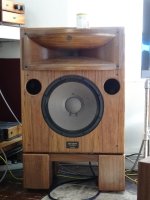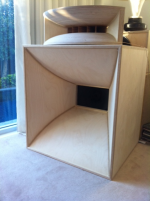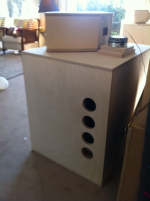Ah! The 2404...
The pinnacle of Pioneer-TAD studio monitors, and one of the very best loudspeaker systems ever produced by anyone, IMHO!
I studied this design in depth, and I'll share some details here for the benefit of whoever might be interested.
The Pioneer Exclusive 2404 (its official name) can be considered a refinement of the previous 2402 model, which was originally introduced in the early 1980s.
The 2402 was a 2-way design splitting the entire audio range into two 5-octave sections (20 - 650 Hz, and 650 - 20k Hz), and utilizing TAD's original 15" AlNiCo-magnet, cellulose-cone woofer (model TL-1601a) and 4" diaphragm/2" exit, AlNiCo-magnet, Beryllium-diaphragm compression driver (TD-4001), mated to the TH-4001 hypex radial horn (which featured a series of vanes in the first section to achieve wide horizontal dispersion up to 10 kHz).
Component-wise, the later (and sadly, much shorter-lived and now much rarer) 2404 model had:
- the woofer updated to its latest incarnation (model TL-1601c), which sported a sinlge-piece frame and improved ventilation and power handling (see spec-sheet in attachment);
- the compression driver replaced by model TD-4003, which featured a redesigned phase plug for even better linearity in the top octaves, and a 1.5" (instead of 2") exit, in order to improve dispersion of those same highest frequencies, which enabled Pioneer to forego the use of vanes in the first section of the horn (see below). It is worth noting that the TD-4003, however, was not a rapid-flare "throatless" design like the contemporary JBLs, but retained an internal slow flare rate in order to still be able to be comfortably crossed over at the same low 650Hz frequency;
- the horn replaced by a completely new design (TH-4003, see attachment). This was still fundamentally a slow-flare radial hypex horn, carved out of a dense block of Itaya Maple, but it featured asymmetrical upper and lower "lips" (APAXIAL design), and a tuned duct (named "AFAST") in the upper lip acting as a Helmotz resonator and "trapping" the last tiny remains of unwanted resonances. Also, unlike the earlier TH-4001, it no longer needed internal vanes to achieve the target dispersion up to 10kHz.
But the jewel in the crown of these loudspeaker systems was arguably their passive crossover (see attachment): this was a very clever asymmetrical design featuring:
- a 6th order Linkwitz-Riley low-pass filter on the woofer branch, and
- a 2nd order electrical high-pass filter on the compression driver branch.
When combined with the natural high-pass response of the driver+horn, and with the compression driver's acoustic centre set back from the woofer's as is the case when the horn is mounted to the loudspeaker enclosure, this crossover results in a flat frequency response AND a perfect overlap of the acoustic phase traces of the woofer and the driver+horn in a wide frequency range around the crossover frequency.
Also, the group delay induced by the steep low-pass filter on the woofer essentially re-aligned in time its emission with that of the compression driver, resulting in an overall flatter group delay curve.
And, finally, the same steep LP also did away with any residual "nasties" at the top of the woofer's operating range.
Several birds with one stone - very clever indeed.
For kicks, I have simulated the crossover using X-Sim - see attachments.
(please note: in the real 2404 system, the compression driver is attenuated using an autoformer + shunt resistor, which results in an almost perfectly resistive 13 Ohm load; since X-Sim does not permit the simulation of autoformers, I simulated this using a 5 Ohm resistor in series with its "default" flat 8 Ohm impedance for the compression driver, which gives the exact same 13 Ohm load)
The pinnacle of Pioneer-TAD studio monitors, and one of the very best loudspeaker systems ever produced by anyone, IMHO!
I studied this design in depth, and I'll share some details here for the benefit of whoever might be interested.
The Pioneer Exclusive 2404 (its official name) can be considered a refinement of the previous 2402 model, which was originally introduced in the early 1980s.
The 2402 was a 2-way design splitting the entire audio range into two 5-octave sections (20 - 650 Hz, and 650 - 20k Hz), and utilizing TAD's original 15" AlNiCo-magnet, cellulose-cone woofer (model TL-1601a) and 4" diaphragm/2" exit, AlNiCo-magnet, Beryllium-diaphragm compression driver (TD-4001), mated to the TH-4001 hypex radial horn (which featured a series of vanes in the first section to achieve wide horizontal dispersion up to 10 kHz).
Component-wise, the later (and sadly, much shorter-lived and now much rarer) 2404 model had:
- the woofer updated to its latest incarnation (model TL-1601c), which sported a sinlge-piece frame and improved ventilation and power handling (see spec-sheet in attachment);
- the compression driver replaced by model TD-4003, which featured a redesigned phase plug for even better linearity in the top octaves, and a 1.5" (instead of 2") exit, in order to improve dispersion of those same highest frequencies, which enabled Pioneer to forego the use of vanes in the first section of the horn (see below). It is worth noting that the TD-4003, however, was not a rapid-flare "throatless" design like the contemporary JBLs, but retained an internal slow flare rate in order to still be able to be comfortably crossed over at the same low 650Hz frequency;
- the horn replaced by a completely new design (TH-4003, see attachment). This was still fundamentally a slow-flare radial hypex horn, carved out of a dense block of Itaya Maple, but it featured asymmetrical upper and lower "lips" (APAXIAL design), and a tuned duct (named "AFAST") in the upper lip acting as a Helmotz resonator and "trapping" the last tiny remains of unwanted resonances. Also, unlike the earlier TH-4001, it no longer needed internal vanes to achieve the target dispersion up to 10kHz.
But the jewel in the crown of these loudspeaker systems was arguably their passive crossover (see attachment): this was a very clever asymmetrical design featuring:
- a 6th order Linkwitz-Riley low-pass filter on the woofer branch, and
- a 2nd order electrical high-pass filter on the compression driver branch.
When combined with the natural high-pass response of the driver+horn, and with the compression driver's acoustic centre set back from the woofer's as is the case when the horn is mounted to the loudspeaker enclosure, this crossover results in a flat frequency response AND a perfect overlap of the acoustic phase traces of the woofer and the driver+horn in a wide frequency range around the crossover frequency.
Also, the group delay induced by the steep low-pass filter on the woofer essentially re-aligned in time its emission with that of the compression driver, resulting in an overall flatter group delay curve.
And, finally, the same steep LP also did away with any residual "nasties" at the top of the woofer's operating range.
Several birds with one stone - very clever indeed.
For kicks, I have simulated the crossover using X-Sim - see attachments.
(please note: in the real 2404 system, the compression driver is attenuated using an autoformer + shunt resistor, which results in an almost perfectly resistive 13 Ohm load; since X-Sim does not permit the simulation of autoformers, I simulated this using a 5 Ohm resistor in series with its "default" flat 8 Ohm impedance for the compression driver, which gives the exact same 13 Ohm load)
Attachments
-
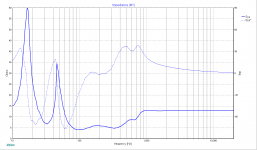 X-sim Z.png26.8 KB · Views: 1,182
X-sim Z.png26.8 KB · Views: 1,182 -
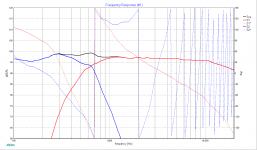 X-sim FR.png36.2 KB · Views: 1,605
X-sim FR.png36.2 KB · Views: 1,605 -
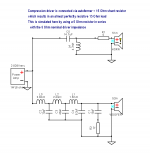 X-sim schema.png15.6 KB · Views: 2,966
X-sim schema.png15.6 KB · Views: 2,966 -
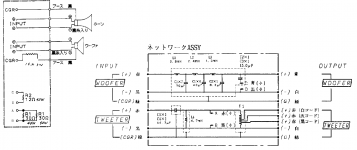 x-over.png37 KB · Views: 3,083
x-over.png37 KB · Views: 3,083 -
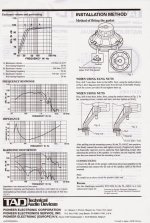 TL-1601c_spec2.jpg217.4 KB · Views: 3,008
TL-1601c_spec2.jpg217.4 KB · Views: 3,008 -
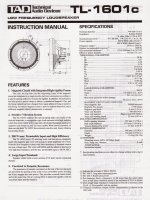 TL-1601c_spec1.jpg202.2 KB · Views: 3,036
TL-1601c_spec1.jpg202.2 KB · Views: 3,036 -
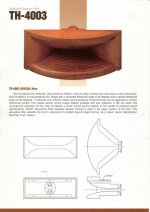 TH4003_spec.jpg46.5 KB · Views: 2,229
TH4003_spec.jpg46.5 KB · Views: 2,229 -
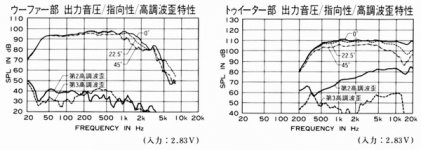 model2404 woofer and driver+horn.jpg50 KB · Views: 1,430
model2404 woofer and driver+horn.jpg50 KB · Views: 1,430
Last edited:
Marco ,
Thank you so much for the information . I was lucky to find the parts on a shelf in Japan , did a bit of research and jumped on them .
I see you’re in London also , I’m South east please feel free to drop in anytime for a chat and listen if you’re in the area . Id love to learn more about them
Richard
Thank you so much for the information . I was lucky to find the parts on a shelf in Japan , did a bit of research and jumped on them .
I see you’re in London also , I’m South east please feel free to drop in anytime for a chat and listen if you’re in the area . Id love to learn more about them
Richard
Thank you!
I'm about to leave on a trip to the US now, but I'll definitely get in touch when I'm back.
You'll be welcome to come and listen to my similar-ish DIY speakers too
Marco
I'm about to leave on a trip to the US now, but I'll definitely get in touch when I'm back.
You'll be welcome to come and listen to my similar-ish DIY speakers too
Marco
... Yuichi 290 horn, and Radian beryllium 950 drivers...
Great components per se, but possibly not an ideal match to one another. Let me elaborate a bit:
The Yuichi A290 horn is a Fc=290Hz, T=0.7 hypex, and its throat adapter is also designed to the same Fc & T parameters, and has a narrow initial expansion angle. It was designed this way to be a perfect match for the TAD TD-4001 compression driver, whose internal conical throat is characterised by a 10º exit angle, and its dimensions (depth, initial area and exit area) are a perfect fit to a Fc=290Hz, T=0.7 hypex expansion.
TAD TD-4001 internal structure:
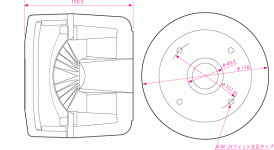
Incidentally, the JBL 2450 is also 100% compatible, since it has the exact same throat geometry and exit angle (10º total).
The Radian 950PB driver, instead, is a more modern "rapid-flare" design, with all the pro's (wider dispersion > 7kHz, IF mated to an equally rapid-flare "waveguide") and con's (worse loading < 800Hz) that that entails. In particular, its very short internal throat has a much wider exit angle of approximately 20º total (10º per side), and its dimensions would lead to a much higher equivalent Fc.
Radian 950PB vs. JBL 2450: (notice the JBL's deeper "snout", which houses the longer and more narrow internal throat)
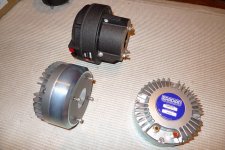
[see also: here]
So, bolting the Radian driver on to the Yuichi A290 horn will create a sharp mismatch at the delicate driver-to-throat adapter junction, which is not ideal.
I'm sure it will probably still sound (very) good overall... but my point is simply that one cannot just mix-'n'-match drivers and horns willy-nilly and expect the two to work seamlessly together.
Marco
Last edited:
Both, the OP's and Marco's Speakers look very sexy I must enviously admit (my large MTM doesn't look nearly as nice).
Regarding Radian Drivers: The Model 745 with 1.4" throat looks very nice too - at least on paper. It is also available in Be. It has a smaller opening angle (around 10 degrees) than the 950. Vance Dickason tested the 745 and the 950. On paper I like the 745 even a little better (and the Be variant even more). A modern horn with almost the same opening angle as the 745 (without diffraction slots and the like) is the oval one from Ciare, which is conical in the horizontal dimension and the vertical shape is such that the horn area follows a hyperbolic function. The downside is the quite narrow radiation compared to all those sexy wooden radials.
The 745NEOBe Compression Driver from Radian Audio | audioXpress
https://pearl-hifi.com/06_Lit_Archive/02_PEARL_Arch/Vol_16/Sec_53/Voice_Coil/2014/2014_11_Nov.pdf
Regards
Charles
Regarding Radian Drivers: The Model 745 with 1.4" throat looks very nice too - at least on paper. It is also available in Be. It has a smaller opening angle (around 10 degrees) than the 950. Vance Dickason tested the 745 and the 950. On paper I like the 745 even a little better (and the Be variant even more). A modern horn with almost the same opening angle as the 745 (without diffraction slots and the like) is the oval one from Ciare, which is conical in the horizontal dimension and the vertical shape is such that the horn area follows a hyperbolic function. The downside is the quite narrow radiation compared to all those sexy wooden radials.
The 745NEOBe Compression Driver from Radian Audio | audioXpress
https://pearl-hifi.com/06_Lit_Archive/02_PEARL_Arch/Vol_16/Sec_53/Voice_Coil/2014/2014_11_Nov.pdf
Regards
Charles
JBL 2450sl with JBL 1500AL
IMO the best would be to throw them away ! I could assist you if necessary !
I stopped counting pennies when I built the 2404 . I’m using Truextent in my next project in a JBL 2450sl with JBL 1500AL . I have H9800 horn , but open to other ideas in the search for a dispersion pattern more like the TH4003 .
The JBL 2450SL (with Be dias) + H9800 horn is an excellent combination for sure, albeit probably not really any better (just a bit different) than the TAD TD-4003 + TH-4003.
But one significant difference is that the H9800 horn is smaller, and really only good down to 800Hz (and even that is stretching it a bit - I think 850 or 900Hz would be better), while the TH-4003 is bigger and works well down to 650Hz, both in terms of acoustic loading, and pattern control.
Still, the JBL 1500AL woofer plays nicely up to 850-900Hz, so if you stick to that crossover frequency range, and use a steep low-pass on the woofer, you should be golden. Just don't try and push the horn too low - that would be my advice.
It will be very interesting indeed to compare these two very similar TOTL systems:
JBL - vs. - TAD
Woofer) 15" AlNiCo magnet - vs. - 15" AlNiCo magnet
Driver) 4"Be dia/1.5"exit, Nd magnet - vs. - 4"Be dia/1.5"exit, Nd magnet
X-over) 850Hz - vs. - 650Hz
Keep us posted!
Marco
- Home
- Loudspeakers
- Multi-Way
- New Project - TAD 2404 Clone
